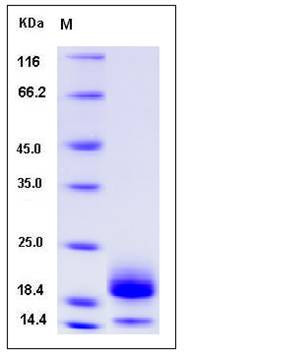Mouse Cystatin E / CST6 Protein (His Tag)
1110017E11Rik,ichq,N28197
- 100ug (NPP2711) Please inquiry
| Catalog Number | P50916-M08H |
|---|---|
| Organism Species | Mouse |
| Host | Human Cells |
| Synonyms | 1110017E11Rik,ichq,N28197 |
| Molecular Weight | The secreted recombinant mouse CST6 comprises 132 amino acids and has a calculated molecular mass of 15.2 kDa. As a result of glycosylation, the apparent molecular mass of rmCST6 is approximately 20 kDa in SDS-PAGE under reducing conditions. |
| predicted N | Glu 29 |
| SDS-PAGE |  |
| Purity | > 90 % as determined by SDS-PAGE |
| Protein Construction | A DNA sequence encoding the extracellular domain of mouse CST6 (NP_082899.1) (Met 1-Ala 152) was expressed, with a C-terminal polyhistidine tag. |
| Bio-activity | Measured by its ability to inhibit papain cleavage of a fluorogenic peptide substrate ZFR-AMC,R&D Systems, Catalog # ES009. The IC50 is < 20 nM. |
| Research Area | Cancer |Signal transduction |Protein Trafficking |Organelle Proteins |
| Formulation | Lyophilized from sterile PBS, pH 7.4 1. Normally 5 % - 8 % trehalose and mannitol are added as protectants before lyophilization. Specific concentrations are included in the hardcopy of COA. |
| Background | Cystatin E/M, also referred to as CST6, is a member of type 2 cysteine proteinase inhibitors of the cystatin superfamily, and inhibits papain and cathepsin B. Cystatin E is a low molecular mass secreted protein existing in both a glycosylated (17 kDa) and an unglycosylated (14 kDa) form, with two characteristic intrachain disulfide bridges. Expression of cystatin M/E is found to be restricted to the epidermis, more specifically in the stratum granulosum, sweat glands, sebaceous glands, and the hair follicles. In addition to its function as a cysteine protease inhibitor, cystatin M/E also serves as a target for cross-linking by transglutaminases. Accordingly, cystatin M/E was suggested to be involved in barrier formation and maintenance. Furthermore, studies have revealed that cystatin M/E is frequently epigenetically inactivated during breast carcinogenesis, and thus be regarded as a candidate of tumour suppressor gene. |
| Reference |
